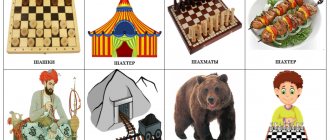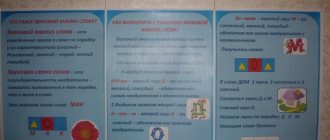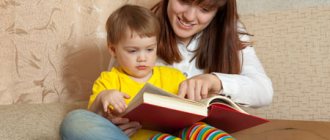Modern children, for the most part, go to school already prepared: they know how to read, write, count, and solve simple problems. Some attend school preparation courses, others work individually with a teacher, but many parents prefer to prepare their child for school on their own.
The child learned letters, learned to combine them into syllables, and syllables into words. And the parents are very happy; they have something to be proud of in front of their neighbors. Especially if the neighbors’ children only play with toys and don’t know a single letter.
But we cannot stop there. Otherwise, the acquired skills will quickly self-destruct. Now it's time to move on to reading short texts. This is a very difficult but interesting task for a child. After all, by perceiving the text, the child receives a lot of information that is useful and exciting for him.
Parents and teachers often find themselves at a loss as to how to offer texts to a preschooler, in what form it will be more effective, and how to begin to develop syllable reading at this age.
Learning letters and learning how to put them into words is not an easy task. It happens that parents give up during the learning process. Taking age into account is an important point. This is where we will begin our discussion.
This article will discuss how to make learning enjoyable for parents and their little students.
Age characteristics of preschoolers
Five-year-old children are very active and inquisitive. At this age, “growing up” happens right before our eyes. Children develop not only physically, but also mentally and intellectually.
During this period, the child begins to prepare for school. Cognitive mental processes begin to form with great acceleration. Children constantly ask adults questions.
The beginning of the formation of cognitive interests contributes to the development of imagination and fantasy. Thanks to these processes, the formation of the creative potential of the preschooler’s personality begins.
Children gain knowledge through all types of activities - games, classes, various productive and leisure activities.
I decided to invite you to work with your child (and it will be no less interesting for you) using the following method.
You choose a level, carefully read the sentence, and then compose it from scattered syllables and letters.
Depending on the level, sentences are lengthened by a certain number of words. This allows you to improve your skills in memorizing and putting words together from syllables.
To make the task more difficult, you can turn on the timer and try to compose sentences within the allotted period of time. The timer can be stopped at any time.
If the sentence is still too complex for the child, you can skip it by clicking on the “Next” button.
After the proposal has been completed, click on the “Check” button. The result will speak for itself.
Have fun practicing your reading and memorization skills!
Full screen
Game “Composing words from syllables”
Here you can completely do without pictures. To play, you will need to write several two-syllable words on cards, for example, “river”, “mother”, “lotto”, “accordion”, “leg”, “hand”, etc. Then you need to cut the cards into two halves and mix them.
The child’s task is to compose words from syllables, and he must choose the sequence independently. In addition to the fact that the baby will learn to read words correctly, he will also understand their semantic meaning. If non-existent words appear, point this out to him, but if he makes up words that are unfamiliar to him, explain their meaning.
A similar game can be played with words of three syllables. Often this option is much more interesting than the first.
5
When can you start teaching your child to read?
Reading should be taught only when speech therapy problems, if any, have been resolved. Speech disorders can lead to dyslexia (impaired reading process), and in the future to dysgraphia (impaired writing process). The consequence of all this will be low performance at school.
If a child does not pronounce a couple of “uncontrollable” sounds, but in general his speech is clear, this is not so critical. If the baby has porridge in his mouth and cannot pronounce half of the letters, then first of all it is necessary to correct his oral speech with the help of a speech therapist. When learning the alphabet, the baby will learn the letters the way he hears and pronounces them himself, and this will lead to problems in reading and writing.
Age is also important. There are methods that allow you to teach very young children, but you need to understand: is the child really ready to learn, does he understand the explanations, does he like the lessons. Here it is very important to grasp the fine line between the child’s psychological readiness for learning and the ambitions of his parents.
If there are no speech therapy problems or they have already been resolved, if the baby is ready to learn, then it is worth introducing him to the alphabet, and then moving on to reading syllables.
Game "Composing words from letters"
A game similar to one of those discussed above. The only difference is that you need to play it with your child only in those cases when, when reading, he does not switch to letter-by-letter reading and has already adapted to pronouncing and voicing merged syllables.
To play the game, you will need to cut out letters from some alphabet (you can even donate two or three alphabet letters for this task). The letters are laid out in front of the child, and he must form existing words from them.
It is more interesting to play this game if you specifically select a set of letters. For example, place the letters F, E, N, O, T, L, E in front of your baby and see what words he can make up from them. If you want to complicate the game, you can give your child the task of forming two words at the same time, having prepared the appropriate set of letters in advance. For example, put the letters Y, O, S, Ch, K, A in front of him, and give him the task of making up two words denoting the names of drinks (it is recommended to choose words related to one general concept, but when the task becomes easy, this recommendation can be omitted stick to).
9
Positive experience
Emotionally developed, full of impressions, preschoolers quickly gain positive learning experiences. Additional incentive in the form of praise and support helps children self-motivate for educational activities.
Thanks to the rapid development of memory, attention, and mental operations, five to seven-year-old preschoolers are already able to receive and process a large flow of information. But this should not be abused. Still, this is a child’s brain, and the dose of information should be calculated specifically for the child’s age stage and the corresponding cognitive experience of the child.
What difficulties may arise when reading words?
It happens that children have difficulty reading words that are not divided into syllables, and try to find syllables where there are none (a common example: “kn-i-ga”, where the division into syllables is incorrect). If your child also experiences a similar difficulty, we advise you to help him at first by highlighting fusion syllables. You just need to point with a pencil at the syllable and tell how to read it correctly.
Another quite common difficulty is difficulty reading long words. In such situations, we recommend dividing the word into syllables with your child. First, write down the last syllable on the sheet of paper and read it with your child, then the penultimate one, etc., until you get to the whole word. For example, if this is the word “mousetrap”, first write down KA and read, then – LOV (it turns out to be a LOVE), then SHE (it turns out to be a MOUSETRAP), then WE (it turns out to be a MOUSETRAP). By helping your child in this way, you will also prevent him from thinking out words incorrectly.
And one more nuance: pay attention to the words in your child’s primer or alphabet book. Often, some authors try to include in their manuals a lot of words that are quite easy to compose using the letters available on the pages (as a rule, these are more complex specific words like “phase”, “dye”, “relay”, “pump”, etc. .). In these cases, it will be more optimal not to focus on these words, but instead of reading and studying them, use them in the above exercises.
This lesson brings the main reading teaching portion of the course to an end, and the final three lessons will have a slightly different focus. In the eighth lesson we will talk about how to help your child read faster.
Preschooler's speech
The most important acquisition in preschool age is considered to be correctly formed speech and sufficient vocabulary.
Preschoolers already know many poems, riddles and fairy tales by heart.
But in order for a child’s personality to develop, it is necessary to diversify the information and complicate the learning material. This will spur the baby’s curiosity and develop in him a desire to learn even more new and unknown things.
It is important to remember that teaching preschoolers should take place in a playful, unobtrusive form. Otherwise, the child will quickly lose interest in what is happening, and in the future, reading will only cause hostility.
Classes must be held regularly, and the material covered must be reinforced every day. To do this, it is not necessary to constantly sit with a primer and do exercises. You can look for familiar letters or words on signs, product packaging, or magazine titles at the newsstand.
It is necessary to become interested in reading from an early age. The good old tradition of reading fairy tales before bed will help perfectly with this. A personal example is also important: it will be useful for a child to see his parents not only in front of a TV or laptop screen, but also with a book in their hands.
Game "Finish the word"
Another game with pictures, but in this case absolutely any pictures will do, from postcards to magazine clippings. Using paper clips, you need to attach pieces of paper to the pictures with the first letters of the names of what is depicted on them written on them. The endings of words also need to be written on pieces of paper and laid out in front of the child. His task is to look at the image, read the beginning of the word and find a piece of paper with a suitable ending (for variety, add non-existent endings to the pieces of paper).
There is another version of this game, but without pictures. The beginnings of words that relate to one general term (animals, dishes, clothes, furniture, shoes, seasons, etc.) are written on the cards. On other cards the endings of words are written. The child’s task is to correctly form the words, and then say how all this can be called in one word, for example: “boots” + “sneakers” + “felt boots” “shoes”, “coat” + “pants” + “skirt” “clothes” and so on.
6
Algorithm for teaching reading
Alphabet
First you need to introduce your baby to the alphabet. To do this, we have developed a simulator, the work of which can be found here.
Full screen
Learning should start with hard vowels: A, O, U, E, I, Y. Then move on to hard voiced unpaired consonants: L, M, N, R. At the end, move on to complex vowels: E, E, Yu, I and consonants that are difficult for a preschooler to perceive - hissing, deaf, hard voiced paired (B, V, G , D).
When naming consonants, you cannot designate them as “em”, “el” or “me”, “le”. You need to pronounce the sound itself. For example, “This letter sounds like this: “m.” Otherwise, the child may not learn to put letters into syllables and when reading there is a risk of getting something similar to “me-a-me-a” instead of “ma-ma.”
Syllables
The next step is to connect the letters into syllables. Methods of teaching this will be discussed in detail below.
Words
The ultimate goal of learning is to add syllables into words and develop continuous reading skills.
Exercise “Chains of words”
At first, when reading words, many children begin to repeat the first syllables. For example, when reading a two-syllable word, the first syllable is repeated, when reading a three-syllable word, the first and second syllables, etc. This happens for the reason that thanks to repetition, words are better understood, and by the time the last syllable is read, the first is not forgotten.
Thus, in order for syllable-by-syllable reading to become normal reading, you can use chains of words in which the last syllable of one word is the initial syllable of the next, for example: “ki-no-ta-ra-sa-ni-na”, etc. When reading such chains, the baby does not need to repeat the first syllable all the time, because it would have already been read in the previous word. This makes reading much easier and much more interesting.
It can be difficult for a child to read such word chains in a book, because a lot of letters and syllables fall into his field of vision. To simplify the procedure, you can either write such chains on separate sheets, or cut out a “window” in a small paper square, into which only 2-3 syllables will fit.
If you decide to use cards, then lay them out in pairs, and as you read, add new syllables and remove previous ones. Here is another example of such syllables: “ra-no”, “no-gi”, “gi-rya”, “rya-ba”, “ba-nya”, “nya-nya”, etc.
3
How to work with texts
You can start working with texts with small poems and very small stories.
A preschooler cannot always grasp the meaning of the text. Therefore, the learning process should be structured approximately as follows:
Choose small cards with short sentences. For four-year-olds, the text on the card should contain no more than 1-3 sentences.
Older preschoolers should be offered cards containing 4-5 sentences.
The sentences selected are not long. There should be few words in a sentence. And they shouldn't be too long. To begin with, it is better to place the sentences themselves on the card as simple ones or with one comma.
Such texts are easily perceived by preschoolers. But you can’t stay at this level of complexity for long.
It is necessary to move on to text reading using cards only when syllabic reading has been mastered at a good level and brought to automatism. At this point, you can move on to texts with unfamiliar information.
It's not just children who should read. It is better to do this one by one or in a chain if this activity takes place in a kindergarten group.
You can't rush the baby. And even worse - start giving him hints. This will only lead to the fact that the preschooler will always stop at difficult places in the text, waiting for a hint.
Not reading speed, but understanding the meaning of the information provided in the text is more important at the learning stage.
LiveInternetLiveInternet
For a child to master reading, you need patience, time and high-quality short simple texts to read, which the child himself could read syllable by syllable, understand and retell. We offer you a selection of such texts. For your convenience, the number of words is written next to each text so that you can choose the text that is optimal in length for your child. Each text is available for download in *.docx format in large font, syllable by syllable. At the initial stage, children should be offered only texts divided into syllables, printed in large letters. Some texts come with a small coloring picture as a small prize for reading the text.
Snow White
Snow White prepared breakfast for the dwarfs in the morning.
She cooked everything very tasty. Snow White poured them tea with milk and baked pancakes with condensed milk and jam. But she never allowed me to sit at the table with dirty hands. The gnomes got used to it and began to wash their hands before eating without being reminded. (44 words) New Year
Before the New Year, a beautiful fluffy Christmas tree was decorated in kindergarten. The children themselves hung various toys, balls, cones, garlands and flags on it. And the boy Sasha put a red star on the top of the tree. The children were looking forward to Santa Claus and shouted in unison: “Santa Claus!” Santa Claus came to the kids with a big bag of gifts. There were enough gifts for everyone. (54 words)
Kitten and puppy
One day a puppy saw a kitten. - What is your name? – the puppy asked the kitten. “Woof,” answered the kitten. -Why are you teasing? – the puppy was offended. – That’s my name – WOOF! - said the kitten. - I did not mean that. Let's be friends! So the Kitten and the Puppy became friends. (43 words)
Wildflowers
It was a hot summer day. The sun was shining brightly. The sky was blue. Three girls Katya, Marina and Yulia were picking flowers in the field. They picked a bouquet of different flowers: daisies, cornflowers, dandelions. And then we wove beautiful wreaths for our heads from wildflowers. (39 words)
How Sasha saw the plane
It was spring, the snow was melting, streams were flowing. Sasha floated paper boats across the water. Suddenly something buzzed overhead. Sasha thought that a bird was flying. Now it's already over your head. It was an airplane. Sasha looked at the plane, and the boats sailed away. (36 words)
Kitty
Mom and dad bought me a kitten. The kitten was small. I gave him milk. The kitten was sleeping and I didn’t wake him up. And when he woke up, he played with me. (26 words)
Butterfly
It was spring. The sun was shining brightly. Flowers grew in the meadow. A yellow butterfly flew above them. Suddenly a large black bird flew in. She saw a butterfly and wanted to eat it. The butterfly got scared and sat on a yellow flower. The bird flew around, flew, but did not see the butterfly. So she flew away with nothing. (47 words)
In zoo
The students in our class went to the zoo. They saw many animals. A lioness and a little lion cub were basking in the sun. The hare and the hare were gnawing cabbage. The she-wolf and her cubs were sleeping. A turtle with a large shell crawled slowly. The girls really liked the fox. (36 words)
Summer holidays
Hot summer has arrived. Roma, Slava and Lisa and their parents went to Crimea. They swam in the Black Sea, went to the zoo, and went on excursions. The guys were fishing. It was very interesting. They remembered these holidays for a long time. (34 words)
Cubes
Mom gave Vova some cubes. The cubes were beautiful, bright: yellow, red, blue, green. Vova was very happy with the gift! He immediately began to build a tall tower from the cubes. In the evening, Vova invited Nikita to visit him. The boys played builders together. (38 words)
Mushrooms
The guys went into the forest to pick mushrooms. Roma found a beautiful boletus under a birch tree. Valya saw a small oil can under the pine tree. Seryozha spotted a huge boletus in the grass. In the grove they collected full baskets of various mushrooms. The guys returned home happy and happy. (38 words)
kind girl
(K.V. Lukashevich) It was a harsh winter. Everything was covered with snow. It was hard for the sparrows. The poor things could not find food anywhere. Sparrows flew around the house and chirped pitifully. The kind girl Masha took pity on the sparrows. She began collecting bread crumbs and sprinkled them on her porch every day. The sparrows flew in to feed and soon stopped being afraid of Masha. So the kind girl fed the poor birds until spring. (61 wordsj)
Hedgehog
Zhenya and Zoya found a hedgehog in the forest. He lay quietly. The guys decided that the hedgehog was sick. Zoya put it in the basket. The children ran home. They fed the hedgehog milk. Then they took him to a living corner. Many animals live there. Children look after them under the guidance of teacher Zinaida Zakharovna. She will help the hedgehog recover. (50 words)
AND A LOT MORE: https://www.mam-club.org/%D1%82%D0%B5%D0%BA%D1%81%D...%D0%BC-4-7-%D0%BB% D0%B5%D1%82/
Where can I get cards with texts for preschoolers?
You can make cards yourself or find age-appropriate ones on the Internet. If we make cards ourselves, then we can make sentences in such a way that they tell about the child himself.
Even write down his name. This will definitely interest the young reader, and he will want to know what is written about him.
The text in sentences should be made large and bold. This will facilitate visual perception of information. At the first stages, a hyphen is placed between the syllables, which will also make reading easier, because the baby is already familiar with the syllables.
Isographs
Isographs are pictures that are drawn using the letters that represent them. In most cases, the letters themselves are arranged so that the images resemble what the letters represent. The child’s task is to look at the image, read the encrypted word and determine whether it matches the picture or not.
Some examples of good isographs:
The exercises discussed will help your child learn to read words, stop stumbling between syllables, and also perceive the essence of what they read. In general, no problems should arise, but it still makes sense to say a few words about possible difficulties.
11
Texts for reading using cards with pictures
Next, I have selected a small collection of cards that can be printed for activities with preschoolers.
The cards are illustrated, the sentences are selected according to the age of the child in the preschool period.
How to develop speed reading skills?
Cards with reading texts for children from 4 years old
These cards contain a colorful illustration with one sentence based on the picture presented. It will be easy for a child to read the text by looking at the image.
Printed pictures can be folded to make small books that the child will re-read from time to time.
Cards with reading texts for children from 5 years old
The cards below contain more text. After reading them, it will be useful to give your child a simple task.
Reading card 1 Reading card 2 Reading card 3 Reading card 4 Reading card 4 Reading card 2
Related posts:
- Teaching a child to read Teaching reading in preparation for school. When can you teach a child...
- Reading culture - conditions for formation Conditions for the formation of reading culture among schoolchildren in the process of extracurricular activities. Technology…
- D. Davis and his method of speech correction for dyslexics The Davis method for dyslexia has been successfully used to correct speech disorders….
- What is "War and Peace" about? Summary of the novel “War and Peace” by chapters. All answers...
Game "Picture and Word"
The presented game is one of the most common among word games (by the way, it can be found in many bookstores). In the usual version, the game is played like this: the child is given cards with words, and the parent has pictures in his hands. The parent shows the pictures to the child. If among his cards there is a word corresponding to the picture shown, he takes the picture for himself. If not, the game continues.
You can often find a similar game in special reading notebooks. The game involves the child reading a word and connecting it with the image that corresponds to it.
We would like to draw your attention: if you decide to make a similar game yourself, to make it more interesting and rich, add a couple of extra cards to the cards with words and pictures that do not correspond to each other.
4









